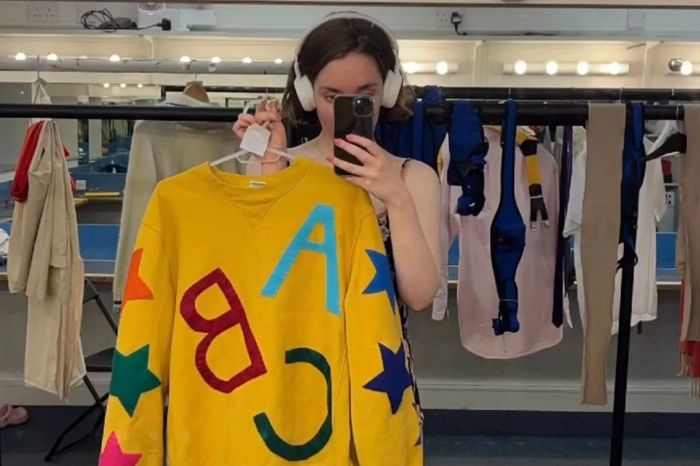The Man Who Wouldn’t Be Murdered comes back to life (again!)
Milly Kotecha chats with the writer and director of this award-winning student musical as it takes on Edinburgh in its third iteration

“I want to see how far we can take it,” states Lily Blundell, the writer-composer of the roaring dark-comedy jazz musical The Man Who Wouldn’t Be Murdered. Following on from their five-star, standing-ovation run at the Camden Fringe in 2022, I sit down with Blundell and Izzy Grout (director) to discuss the return of their smash-hit show to the stage at Edinburgh Fringe this August.
The pair have worked on the show since its origin in 2021, and as they reach the end of their three years at Cambridge, the revival comes across as something of a last Camdram hurrah. It takes dedication and innovation to work on a production over the span of three years, and these qualities are very prevalent in the pair as they excitedly talk about the inspiration behind their creative decisions.
Before I can even ask how the jump was made from the legendary tale of Michael Malloy to jazz musical, Blundell informs me that a true crime podcast is to thank for her first insight into his life story. (There you have it folks – something valuable really can come out of a true crime addiction!)
“It takes dedication and innovation to work on a production over the span of three years”
However, the origin of the plot is really one drop in the sea of thought behind the production. The pair passionately speak about how they were forced to examine their own implicit biases towards female characters in the canon of musical theatre. Considering the era (1930s Prohibition New York) was essentially a man’s world, it already leads to stories that purely foreground male characters. Blundell candidly admits that “the main thing we were trying to tackle in this show is how to write female characters.” By the insertion of the character Josephine, the wife of Michael Malloy, along with the transcendent figure of Death (although not explicitly female, the actor playing Death has been female in all versions of their production), this issue of a lack of representation for women is diligently tackled head-on.
Josephine in particular lies outside of the murder plot: she serves as an anchor to her husband, while everyone else is caught up formulating ways to kill… or becoming the victim. The conscious avoidance of 'the strong female' or the 'beaten-down wife' tropes highlights the challenge that has underpinned their entire process. Yet as the show approaches its third series of performances, there is also a slightly different, personal challenge at the forefront of their minds.
“Each decision in this production has an immense amount of consideration behind it”
If I had to describe my hamartia, it would be my inability to accept change. Therefore my full sympathies are with Blundell and Grout as they confess that working with a new cast with their own interpretations and ideas, as “fabulous” as they are, is a big leap. When they have seen huge successes with a certain cast, certain character choices, certain sound, the natural impulse is to stick with what worked. “It is hard to keep an open mind, keep it fresh for the new run.” Blundell admits. As the saying goes, ‘if it ain’t broke don’t fix it.’ However Grout cleverly reverses this sentiment: “It has to be broken even though we don’t need to fix it, because it’s good to keep trying new things.” A metaphor for the ages – and my new life mantra.
Each decision in this production has an immense amount of consideration behind it. In a strive for freshness, Grout details her decision to stage the Edinburgh show in the round, creating an even more immersive experience for the audience. When I ask about the choice of jazz as a genre, Blundell speaks about her love for jazz growing up, and the appropriateness of the musical style for the setting of Prohibition-era New York.
Looking more broadly, even choosing to take on the mammoth task of composing a musical was partially done to enhance the surrealism of the story (because genuinely, how did he survive so many murder attempts?). I ask suggestively whether the violence of the tale is used as a lens for issues of today, but Blundell clarifies that although the violence is prevalent, the tone is dark comedy, so the musical format is perfect for it.
I push about their aspirations for the show, both at Fringe and beyond. Although the answer largely touches on their current focus being enjoyment for the audience, cast and crew, Grout emphatically tells me: “It’s one of those shows that should carry on.” Therefore, you should go on down (or up, for the majority of us) to theSpace at Niddry Street in Edinburgh, to experience the “buzz” of this stand-out show. Who knows which theatre it could be coming to next?
The Man Who Wouldn’t Be Murdered is playing at theSpace @ Niddry Street at the Edinburgh Fringe from Friday 2nd – Saturday 24th August (excluding the 11th and 18th), at 9:30pm.
 Comment / Bonnie Blue is the enemy, not the face, of female liberation13 October 2025
Comment / Bonnie Blue is the enemy, not the face, of female liberation13 October 2025 News / Cambridge climbs to third in world Uni rankings11 October 2025
News / Cambridge climbs to third in world Uni rankings11 October 2025 Features / Beyond reality checkpoint: local businesses risking being forced out by Cambridge’s tourism industry15 October 2025
Features / Beyond reality checkpoint: local businesses risking being forced out by Cambridge’s tourism industry15 October 2025 News / Join Varsity this Michaelmas13 October 2025
News / Join Varsity this Michaelmas13 October 2025 Features / How to spend a Cambridge summer12 October 2025
Features / How to spend a Cambridge summer12 October 2025









